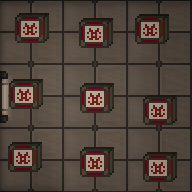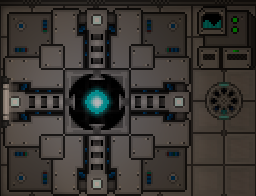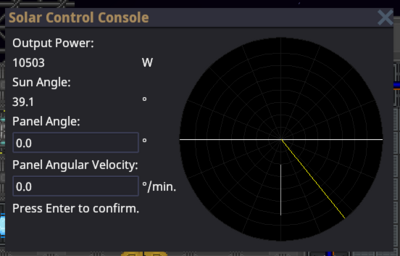Power: Difference between revisions
m Mover AME to the top |
|||
| Line 4: | Line 4: | ||
== Generation == | == Generation == | ||
All power on the station comes from either a generator or an energy storage device. In this section we will discuss generators, and in brief, engines. All engines are generators but not all generators are engines. | All power on the station comes from either a generator or an energy storage device. In this section we will discuss generators, and in brief, engines. All engines are generators but not all generators are engines. | ||
=== The Antimatter Engine Reactor === | |||
The Antimatter Engine Reactor (usually called AME) is the main source of power in the station. First grab the AME parts from the ''Packaged antimatter reactor crate'' and place them in a rectangle/square formation (note that the square/rectangle must be of at least 3x3, otherwise it won't work). | |||
Take your multitool from your belt and click on each one of the AME parts. This will unpack them and spawn an unpassable, indestructible AME shielding. Now open the ''antimatter control unit crate'' which will release an AME Controller. Drag it near the generator a wrench it. Now take an AME fuel jar from the ''antimatter containment jar crate'' and place it in the AME Controller. | |||
Open the AME Controller menu and click on "Toggle injection" bellow the "Engine Status:" text. If the AME and the AME Controller light up then it's currently generating power. Increase the injection amount to be double of the amount of cores; for example: if you have 2 cores click on "Increase" until the "Injection ammount:" reaches 4. The AME should be making "bonks" every now and then. | |||
<div><ul> | |||
<li style="display: inline-block;"> [[File:AME_setup_example1.png|thumb|none|A sample layout of a 3x3 AME]] </li> | |||
<li style="display: inline-block;"> [[File:AME_completed_example1.png|thumb|none|What the AME should look like at the end]] </li> | |||
</ul></div> | |||
=== Solar Power === | === Solar Power === | ||
| Line 28: | Line 40: | ||
The largest size singularity before you risk it breaking loose can generate between 1.4 and 1.6 MW with 24 radiation collectors. This value is verty likely to change and will even change depending on the layout of your engine (radiation falls off over distance so closer collectors will net more power). In future, radiation collectors will also require plasma tanks to function and will run out over time. | The largest size singularity before you risk it breaking loose can generate between 1.4 and 1.6 MW with 24 radiation collectors. This value is verty likely to change and will even change depending on the layout of your engine (radiation falls off over distance so closer collectors will net more power). In future, radiation collectors will also require plasma tanks to function and will run out over time. | ||
=== Supermatter (SM) Engine === | === Supermatter (SM) Engine === | ||
To be added. | To be added. | ||
Revision as of 18:17, 20 February 2022
Power
This guide will cover the basics of power in SS14 as well as how to property setup a distribution grid for the power you generate.
Generation
All power on the station comes from either a generator or an energy storage device. In this section we will discuss generators, and in brief, engines. All engines are generators but not all generators are engines.
The Antimatter Engine Reactor
The Antimatter Engine Reactor (usually called AME) is the main source of power in the station. First grab the AME parts from the Packaged antimatter reactor crate and place them in a rectangle/square formation (note that the square/rectangle must be of at least 3x3, otherwise it won't work).
Take your multitool from your belt and click on each one of the AME parts. This will unpack them and spawn an unpassable, indestructible AME shielding. Now open the antimatter control unit crate which will release an AME Controller. Drag it near the generator a wrench it. Now take an AME fuel jar from the antimatter containment jar crate and place it in the AME Controller.
Open the AME Controller menu and click on "Toggle injection" bellow the "Engine Status:" text. If the AME and the AME Controller light up then it's currently generating power. Increase the injection amount to be double of the amount of cores; for example: if you have 2 cores click on "Increase" until the "Injection ammount:" reaches 4. The AME should be making "bonks" every now and then.
Solar Power
Solar power is a passive means of generating power. A solar array is made up of a number of solar panels, a single solar tracker device and a solar control computer (console) nearby to properly control and manage the panels.
Most if not all solar arrays start off not connected to the station, and need to be connected via HV cables underneath each panel and connected back to the station. Once connected, use the solar control computer to change the angle and speed of tracking for the panels as shown below:
Notice the graph on the right has a T shaped white line and a yellow / golden line. The aim is to alter the panel angle (white T line) to match the sun angle (yellow line). Some experimentation might be needed to setup the angular velocity correctly so that the lines stay in sync and generate maximum wattage.
A typical panel near max output will produce 1500W (1.5kW). This would be enough to power roughly 1 machine and 1 computer (this figure may change as balance changes are made).
Small Portable Generators
The simplest and most basic of all generators on this list is the standard portable generator. This generator when wrenched down on to a tile above a HV cable will produce 3000W (3kW) of electricity to the grid. Currently they do not consume any fuel but in future they consume plasma sheets or gas (likely).
Due to their size these generators are ideal for small shuttles and ships.
Gravitational Singularity Engine
The singularity is one of the most well known and potentially dangerous forms of generating power in SS14. It uses a particle accelerator to fire high energy particles at a singularity generator to spawn a singularity. The singularity then pulses radiation which is absorbed by radiation collectors around it's perimeter.
The singularity must be kept inside a containment field setup with emitters, otherwise if not contained the singularity will consume matter like a black hole and grow to a massive state. If starved of particles or matter, the singularity will slowly shrink until it collapses so once the singularity is of the correct size, it's wise to turn down the particle accelerator to a lower power setting to prevent it growing out of hand.
The largest size singularity before you risk it breaking loose can generate between 1.4 and 1.6 MW with 24 radiation collectors. This value is verty likely to change and will even change depending on the layout of your engine (radiation falls off over distance so closer collectors will net more power). In future, radiation collectors will also require plasma tanks to function and will run out over time.
Supermatter (SM) Engine
To be added.
Transmission & Distribution
Power transmission in SS14 comes in three different flavors, high voltage (HV) cables (orange), medium voltage (MV) cables (yellow) and low voltage (LV) cables (green).
Power flows from generators and power storage via HV cables to substations around the station. From substations, MV cables going out transmit power from the substation and connected grid to area power controllers (APCs) where LV cables take the power the rest of the way to consumers (3-4 tile radius from the APC to devices in the area). A cable must be placed under generators, storage, substations and APCs for them to function.
Separating your Grid
One device not mentioned so far is the cable terminal. In order to separate part of your power network you will need to use a cable terminal, with a HV cable on the terminal box side and the wire side facing towards a SMES. When a HV cable is then placed under the SMES this creates two distinct HV cable networks; the side with your generation on which ends at the cable terminal, and the storage / supply side which starts at the SMES and goes out to substations.
Currently if you place a substation on the generation side of your SMES it will drain into said SMES as a supplier. This is important as in this scenario if there isn't enough generation, the substation will drain to empty causing a blackout in its connected APCs while everything on the SMES side will remain powered.




